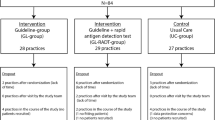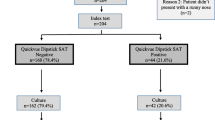Abstract
The main purpose of this paper was to estimate the cost per quality-adjusted life year (QALY) saved by identifying Fusobacterium necrophorum in throat swabs followed by proper antibiotic treatment, to reduce the incidence of Lemierre’s syndrome and peritonsillar abscesses (PTA) originating from a pharyngitis. The second purpose was to estimate the population size required to indicate that antibiotic treatment has an effect. Data from publications and our laboratory were collected. Monte Carlo simulation and one-way sensitivity analysis were used to analyse cost-effectiveness. The cost-effectiveness analysis shows that examining throat swabs from 15- to 24-year-olds for F. necrophorum followed by antibiotic treatment will probably be less costly than most other life-saving medical interventions, with a median cost of US$8,795 per QALY saved. To indicate a reduced incidence of Lemierre’s syndrome and PTA in Denmark, the intervention probably has to be followed for up to 5 years. Identifying F. necrophorum in throat swabs from 15- to 24-year-olds followed by proper antibiotic treatment only requires a reduction of 20–25 % in the incidence of Lemierre’s syndrome and PTA to be cost-effective. This study warrants further examination of the effect of antibiotic treatment on the outcome of F. necrophorum acute and recurrent pharyngitis, as well as the effect on Lemierre’s syndrome and PTA.


Similar content being viewed by others
References
Bisno AL, Gerber MA, Gwaltney JM Jr, Kaplan EL, Schwartz RH; Infectious Diseases Society of America (2002) Practice guidelines for the diagnosis and management of group A streptococcal pharyngitis. Clin Infect Dis 35:113–125
Meier FA, Centor RM, Graham L Jr, Dalton HP (1990) Clinical and microbiological evidence for endemic pharyngitis among adults due to group C streptococci. Arch Intern Med 150:825–829
Lindbaek M, Høiby EA, Lermark G, Steinsholt IM, Hjortdahl P (2005) Clinical symptoms and signs in sore throat patients with large colony variant beta-haemolytic streptococci groups C or G versus group A. Br J Gen Pract 55:615–619
Ehlers Klug T, Rusan M, Fuursted K, Ovesen T (2009) Fusobacterium necrophorum: most prevalent pathogen in peritonsillar abscess in Denmark. Clin Infect Dis 49:1467–1472
Amess JA, O’Neill W, Giollariabhaigh CN, Dytrych JK (2007) A six-month audit of the isolation of Fusobacterium necrophorum from patients with sore throat in a district general hospital. Br J Biomed Sci 64:63–65
Batty A, Wren MW (2005) Prevalence of Fusobacterium necrophorum and other upper respiratory tract pathogens isolated from throat swabs. Br J Biomed Sci 62:66–70
Batty A, Wren MW, Gal M (2005) Fusobacterium necrophorum as the cause of recurrent sore throat: comparison of isolates from persistent sore throat syndrome and Lemierre’s disease. J Infect 51:299–306
Centor RM (2009) Expand the pharyngitis paradigm for adolescents and young adults. Ann Intern Med 151:812–815
Hagelskjaer Kristensen L, Prag J (2008) Lemierre’s syndrome and other disseminated Fusobacterium necrophorum infections in Denmark: a prospective epidemiological and clinical survey. Eur J Clin Microbiol Infect Dis 27:779–789
Chirinos JA, Lichtstein DM, Garcia J, Tamariz LJ (2002) The evolution of Lemierre syndrome: report of 2 cases and review of the literature. Medicine (Baltimore) 81:458–465
Riordan T (2007) Human infection with Fusobacterium necrophorum (Necrobacillosis), with a focus on Lemierre’s syndrome. Clin Microbiol Rev 20:622–659
Karkos PD, Asrani S, Karkos CD, Leong SC, Theochari EG, Alexopoulou TD, Assimakopoulos AD (2009) Lemierre’s syndrome: a systematic review. Laryngoscope 119:1552–1559
Hagelskjaer LH, Prag J, Malczynski J, Kristensen JH (1998) Incidence and clinical epidemiology of necrobacillosis, including Lemierre’s syndrome, in Denmark 1990–1995. Eur J Clin Microbiol Infect Dis 17:561–565
Hagelskjaer Kristensen L, Prag J (2000) Human necrobacillosis, with emphasis on Lemierre’s syndrome. Clin Infect Dis 31:524–532
Jensen A, Hagelskjaer Kristensen L, Nielsen H, Prag J (2008) Minimum requirements for a rapid and reliable routine identification and antibiogram of Fusobacterium necrophorum. Eur J Clin Microbiol Infect Dis 27:557–563
Riordan T, Wilson M (2004) Lemierre’s syndrome: more than a historical curiosa. Postgrad Med J 80:328–334
Aliyu SH, Marriott RK, Curran MD, Parmar S, Bentley N, Brown NM, Brazier JS, Ludlam H (2004) Real-time PCR investigation into the importance of Fusobacterium necrophorum as a cause of acute pharyngitis in general practice. J Med Microbiol 53:1029–1035
Hagelskjaer Kristensen L, Prag J (2008) Localised Fusobacterium necrophorum infections: a prospective laboratory-based Danish study. Eur J Clin Microbiol Infect Dis 27:733–739
Love WE, Zaccheo MV (2006) Lemierre’s syndrome: more judicious antibiotic prescribing habits may lead to the clinical reappearance of this often forgotten disease. Am J Med 119:e7–e9
Jensen A, Hagelskjaer Kristensen L, Prag J (2007) Detection of Fusobacterium necrophorum subsp. funduliforme in tonsillitis in young adults by real-time PCR. Clin Microbiol Infect 13:695–701
Bank S, Nielsen HM, Mathiasen BH, Leth DC, Kristensen LH, Prag J (2010) Fusobacterium necrophorum: detection and identification on a selective agar. APMIS 118:994–999
Miller TL, McNabb SJ, Hilsenrath P, Pasipanodya J, Weis SE (2009) Personal and societal health quality lost to tuberculosis. PLoS One 4:e5080
Heron M, Hoyert DL, Murphy SL, Xu J, Kochanek KD, Tejada-Vera B (2009) Deaths: final data for 2006. Natl Vital Stat Rep 57:1–134
Neuner JM, Hamel MB, Phillips RS, Bona K, Aronson MD (2003) Diagnosis and management of adults with pharyngitis. A cost-effectiveness analysis. Ann Intern Med 139:113–122
Vammen S, Juul S, Henneberg EW, Fasting H, Lindholt JS (2001) What are the direct costs of an abdominal aortic aneurysm repair in a Danish hospital? Ugeskr Laeger 163:5189–5193
Tengs TO, Adams ME, Pliskin JS, Safran DG, Siegel JE, Weinstein MC, Graham JD (1995) Five-hundred life-saving interventions and their cost-effectiveness. Risk Anal 15:369–390
Devlin N, Parkin D (2004) Does NICE have a cost-effectiveness threshold and what other factors influence its decisions? A binary choice analysis. Health Econ 13:437–452
Gehrt B, Jensen A, Kristensen LH, Prag J (2009) Can anaerobic culture of throat swabs prevent Lemierre’s syndrome? Ugeskr Laeger 171:991–992
Tsevat J, Kotagal UR (1999) Management of sore throats in children: a cost-effectiveness analysis. Arch Pediatr Adolesc Med 153:681–688
Centor RM, Allison JJ, Cohen SJ (2007) Pharyngitis management: defining the controversy. J Gen Intern Med 22:127–130
Ehrlich JE, Demopoulos BP, Daniel KR Jr, Ricarte MC, Glied S (2002) Cost-effectiveness of treatment options for prevention of rheumatic heart disease from Group A streptococcal pharyngitis in a pediatric population. Prev Med 35:250–257
Van Howe RS, Kusnier LP 2nd (2006) Diagnosis and management of pharyngitis in a pediatric population based on cost-effectiveness and projected health outcomes. Pediatrics 117:609–619
Hayes CS, Williamson H Jr (2001) Management of Group A beta-hemolytic streptococcal pharyngitis. Am Fam Physician 63:1557–1564
Funding
This research received no specific grant from any funding agency in the public, commercial or not-for-profit sectors.
Conflict of interest
The authors declare that they have no conflict of interest.
Author information
Authors and Affiliations
Corresponding author
Rights and permissions
About this article
Cite this article
Bank, S., Christensen, K., Kristensen, L.H. et al. A cost-effectiveness analysis of identifying Fusobacterium necrophorum in throat swabs followed by antibiotic treatment to reduce the incidence of Lemierre’s syndrome and peritonsillar abscesses. Eur J Clin Microbiol Infect Dis 32, 71–78 (2013). https://doi.org/10.1007/s10096-012-1715-6
Received:
Accepted:
Published:
Issue Date:
DOI: https://doi.org/10.1007/s10096-012-1715-6




